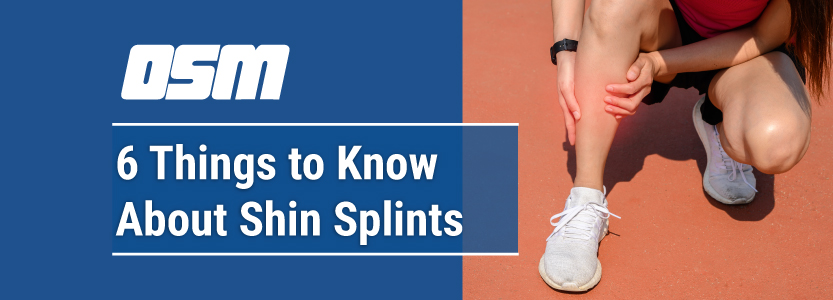6 Things to Know About Shin Splints
Article features on Healthgrades
Shin Splints: Treatment and Prevention
If you’ve ever had a shin splint, you know all about this unique shooting pain. “Shin splint” is the everyday name for tibial stress syndrome—pain and tenderness in the shinbone (tibia) in the front of your leg. Shin splints happen when there’s too much stress on this bone and tissues in your lower leg. The good news about shin splints is there are ways to treat the pain and keep the condition from happening again. Here are key things to help you cope with and prevent shin splints.
1. Shin splints are common.
Many athletes develop shin splints at some point. So do dancers, runners and people in the military. People with flat feet or a very high arch are also prone to having shin splints. You’re more likely to develop shin splints when you push yourself too hard during exercise. Running or doing other exercise too vigorously can cause shin splints. Increasing the length of your workouts too quickly can cause them, too. Exercising on an uneven surface or a very hard surface, like concrete, increases your risk. Wearing old shoes without proper cushioning and support also can lead to shin splints.
2. Know the signs.
Pain from shin splints usually runs along the inside of the front of the bone in your lower leg. It usually occurs in both legs. Your legs will feel sore and tender. They might even swell. The pain from shin splints usually gets better when you take a break from exercise. It often comes back when you start exercising again.
3. Diagnosis is simple.
A doctor can usually diagnose shin splits by doing a physical exam and asking about your medical history and activities. Sometimes, you’ll need an X-ray to rule out other causes of the pain.
4. Don’t push through the pain of shin splints.
It’s important to challenge yourself when you exercise. However, shin splints are typically a sign you’re pushing yourself too hard. If you’re a runner, it may mean you need to change your shoes or where you’re running. Give your body a rest if you develop shin splints. If not, you could develop a stress fracture in your lower leg.
5. You can often treat shin splints yourself.
You don’t usually need to see a doctor to treat a bout of shin splints. Take a break from very heavy exercise that strains your lower leg, like running. Instead, try biking, swimming or walking. Soothe the pain with an over-the-counter pain reliever. Try acetaminophen or a nonsteroidal anti-inflammatory drug (NSAID) like ibuprofen. Ease inflammation in your shins with ice. Protect your legs with a thin towel, and then put an ice pack over your shins for about 15 to 20 minutes. You can repeat this several times a day for a few days. As you start to feel better, slowly return to exercise. Very gradually increase the time and intensity of your workouts.
6. Take steps to prevent shin splints.
Give your legs a strong support system. Buy a good pair of cushioned shoes meant for the activity you’re doing. Consider using a pair of arch supports or other inserts that provide more cushioning. Always stretch before you exercise. If you’re a runner, take a look at your form to see if you can make changes in your stride. That could help relieve stress on your shins. Even when you want to challenge yourself with exercise, remember to not go overboard. Mix in other exercises that don’t put as much impact on your shins—like strength training, yoga, biking, walking or swimming.
The Orthopedic & Sports Medicine Center of Oregon is an award-winning, board-certified orthopedic group located in downtown Portland Oregon. We utilize both surgical and nonsurgical means to treat musculoskeletal trauma, spine diseases, sports injuries, degenerative diseases, infections, tumors and congenital disorders.
Our mission is to return our patients back to pain-free mobility and full strength as quickly and painlessly as possible using both surgical and non-surgical orthopedic procedures.
Our expert physicians provide leading-edge, comprehensive care in the diagnosis and treatment of orthopedic conditions, including total joint replacement and sports medicine. We apply the latest state-of-the-art techniques in order to return our patients to their active lifestyle.
If you’re looking for compassionate, expert orthopedic surgeons in Portland Oregon, contact OSM today.
Phone:
503-224-8399
Address
17355 Lower Boones Ferry Rd Suite 100A
Lake Oswego, OR 97035
Hours
Monday–Friday
8:00am – 4:30pm



